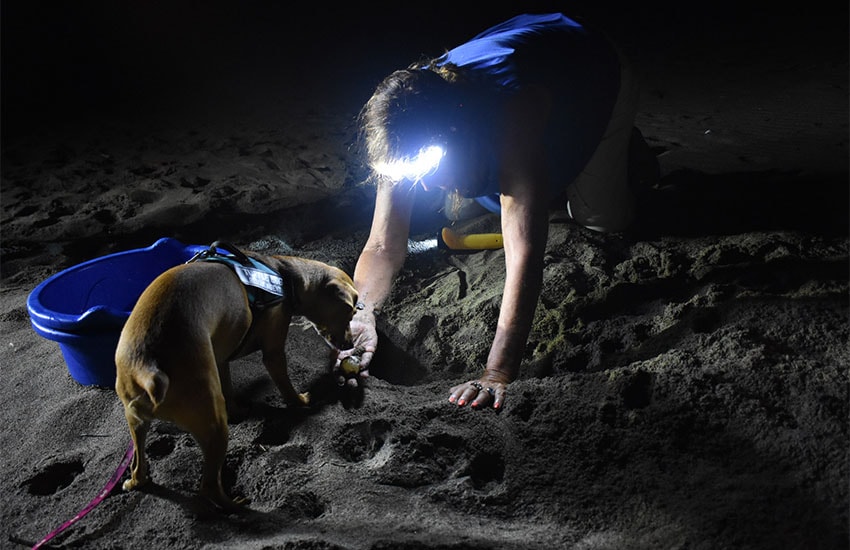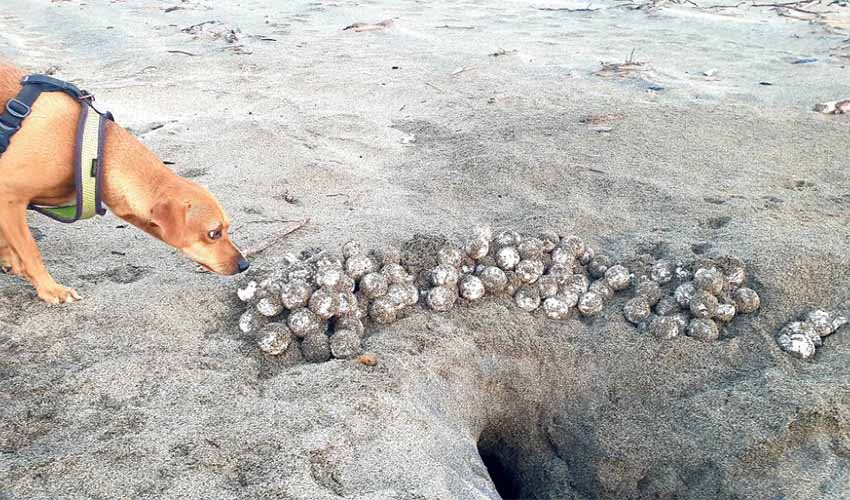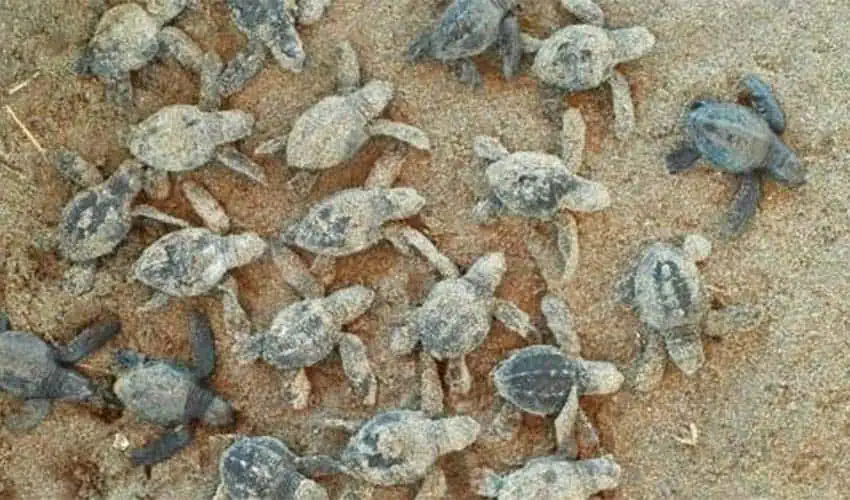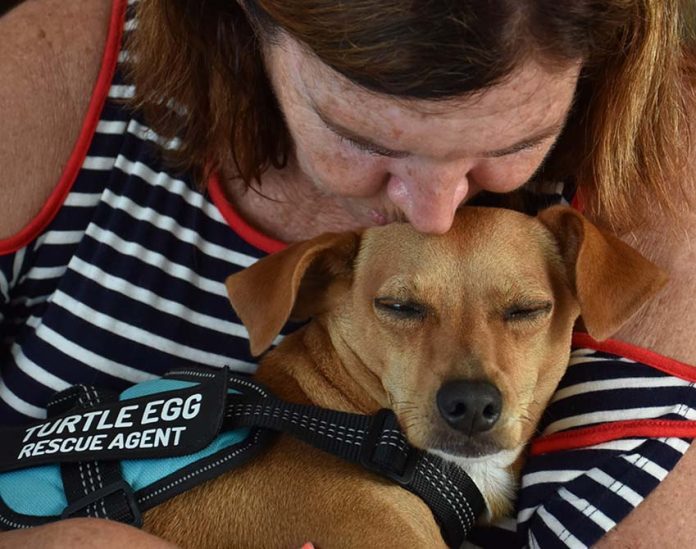Coco sits in my lap in the pre-dawn darkness, shifting anxiously and sniffing the salty air as she waits for her mission to begin. The jacket this dog wears announces the work she does: Turtle Egg Rescue Agent.
Eileen Hoeter, her owner and the person in charge of Coco Turtle Rescue, one of the two turtle sanctuaries in Playa Coco, Jalisco, puts her four-wheel drive jeep in gear, and we start for the beach.
Hoeter and her husband Jed have been running their turtle sanctuary, since they moved to Playa Coco in 2015 and built Villa Star of the Sea, a small resort. “We’d walk on the beach, and we’d see baby turtles or females laying eggs,” she said. “Then ECOBANA, an animal rescue organization in Barra de Navidad, asked us to build a turtle sanctuary.”
Since then, when she’s in Jalisco, she’s out virtually every day before dawn, searching for turtle nests. “You have to be out early to beat the poachers and the dogs,” she said. She is certified by and works under the supervision of the University of Guadalajara.

Coco, however, hasn’t had any training. Adopted as a puppy from a friend who’d found Coco’s mother as a pregnant stray, she tagged along on the turtle egg rescue missions. Before Coco, Hoeter was on her own. “I’d get on my hands and knees and dig.” That could take her up to an hour.
Then, one day, without prompting, Coco started digging. “She can smell the eggs and turtles,” Hoeter said.
Coco will dig deep until she is millimeters from the eggs. She’s careful not to damage them and lets the humans take over. She also guards the eggs from strangers until they are safely in the sanctuary, and then again later as the hatchlings make their way to the sea.
Three species of turtles lay eggs on this beach: olive ridley and green turtles are both designated as “vulnerable,” while the third, the leatherback turtle, is critically endangered.

To find nests, Hoeter scans the beach for turtle tracks, which look remarkably like tire tracks, except turtle tracks run perpendicular to the water’s edge while tire tracks mostly run parallel. As we drive out on a mission, Hoeter pointed out holes surrounded by dried egg shells saying, “Those eggs were eaten by dogs.”
She also showed me empty holes. “Those are poachers,” she said. “They aren’t dangerous.”
Despite a five-year jail term for poaching, people steal eggs to sell for their supposed aphrodisiac properties. While she doesn’t condone poaching, she’s understanding. “They sell the eggs for five or eight pesos,” she said. “They’re trying to make some money.”
When Hoeter spied an eagle with a baby turtle in its beak, she knew there was a nest nearby; Coco located it immediately, with six new turtles still inside. With the sun already up, if Coco hadn’t found them, they almost certainly would have dried out and died before reaching the sea, she said.

Coco located another nest and dug furiously, stopping every few seconds to put her nose deeper in the hole. As soon as she saw white — indicating she’d found the eggs — she stopped digging and backed off, letting Hoeter take over. “You must be very careful,” Hoeter said. “I loosen the eggs and I close my eyes. I do it by touch. I take out some sand—it has the mother’s secretions—and put it in the bucket to cover the eggs.”
When Coco later found yet another nest with 40 or 50 newly hatched turtles, Hoeter placed them in a bucket with some water and took them to the water’s edge.
“You don’t put them directly in the water,” she said. “They pick up something from the sand. Sand here is different from sand in all other places. After three years, females come back here [to lay their eggs]. Males never come back.”
At the turtle sanctuary, Hoeter digs holes the same depth as the original nests, gently places the eggs in and fills them with sand. A stick marks the location. Fifty-five days later, between 75% and 85% of the eggs will hatch, and the babies will be released to the sea.

“Eggs that are laid are asexual,” Hoeter said. “The higher the eggs are [in a nest], the warmer they are and they will become females. It’s cooler at the bottom, and they will become males. With the climate warming, there will be more females.” Baby turtles are a study in determination.
After digging out from a nest buried at least two feet deep, the new turtles head to the water, 50 yards away. They use their flippers like paddles, pushing themselves forward, pausing every three or four seconds to gather themselves for another push. A wave comes in and knocks them back, turning them around, but they point themselves toward the ocean and continue. Finally, they disappear into the water, and the ocean takes them on their inevitable journey.
Baby turtles face all kinds of challenges: as they cross the beach, they’ll be eaten by eagles and terns. Crabs drag them into their holes. Even if the turtles reach the water, they become food for a number of predators.
If they live, they soon are required to find food. Babies have a food sac that keeps them nourished for three days, but after that, they begin hunting for a variety of aquatic insects, plants and small fish.

Hoeter said that it’s thought that one out of a 1,000 survive.
She files regular reports on her work with the University of Guadalajara, recording the number of nests destroyed by dogs or taken by poachers and releases an estimated 8,000-20,000 turtles a season — from November through May.
When asked, she says she hasn’t noticed any change in the number of nests she finds but has seen other changes. “I’ve seen some nests with tiny eggs,” she said. “This has only been in the last two years. These are eggs that won’t hatch.”
Most of the sanctuary’s maintenance is footed by the Hoeters, though they do have fundraisers and accept donations.
Hoeter said she loves her work.
“It’s an amazing thrill to help these creatures,” she said. And, she added, “It’s a beautiful way to start your day.”
- For more information or to donate: [email protected]
Joseph Sorrentino, a writer, photographer and author of the book San Gregorio Atlapulco: Cosmvisiones and of Stinky Island Tales: Some Stories from an Italian-American Childhood, is a regular contributor to Mexico News Daily. More examples of his photographs and links to other articles may be found at www.sorrentinophotography.com He currently lives in Chipilo, Puebla.
